7 aliments surprenants, selon Dr Mercola
Traduction automatique ici : https://tinyurl.com/3jjfev29
7 Surprising Superfoods to Look for at the Store
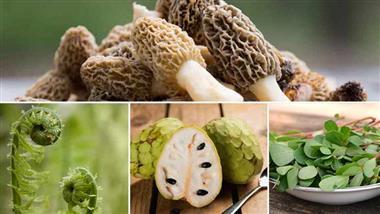
Story at-a-glance
- Eating locally means eating what’s in season. This spring, consider adding some of the following superfoods, many of which you may never have heard of before: morel mushrooms, fiddlehead ferns, cherimoya, sorrel, stinging nettles, purslane and wild leeks
- Most of these are only available for a short amount of time, so start looking for them as soon as they come in season
- Morel mushrooms, which are available only for a few weeks in early spring, are packed with immune-boosting, disease-preventing vitamin D. Fiddleheads are picked from immature, uncoiled ostrich ferns, and have a flavor reminiscent of asparagus
- Cherimoyas contain approximately 60% of the daily recommended dose of vitamin C and a third of your vitamin B6 needs, while nettles provide healthy amounts of vitamin K and calcium
- One cup of sorrel provides more than your daily requirement of vitamins A and C, along with high amounts of potassium and iron; purslane is the omega-3 powerhouse of the plant kingdom
Editor’s Note: This article is a reprint. It was originally published March 26, 2018.
Eating locally grown foods comes with a bounty of benefits, from fresher foods to saving both money and the environment. One 2007 study from the University of Alberta, Canada, determined that the transportation alone of organic produce actually causes an environmental impact large enough to cancel out many of its benefits.1
If you look, you’ll find that most of the organic fruit and vegetables in your local grocery store come from much farther away than your conventional produce. Fresh produce in most regions of the U.S. actually travels over 1,500 miles on the road.2 That’s even higher than processed foods, which are shipped an average of 1,346 miles.3 Eating locally grown foods helps eliminate a substantial amount of the carbon footprint associated with food transportation.
Eating locally automatically means eating what’s in season. This spring, consider adding some of the following superfoods,4 many of which you may never have heard of before. Most of these are only available for a short amount of time, and now’s the time to start looking for them.
No. 1: Morel Mushrooms
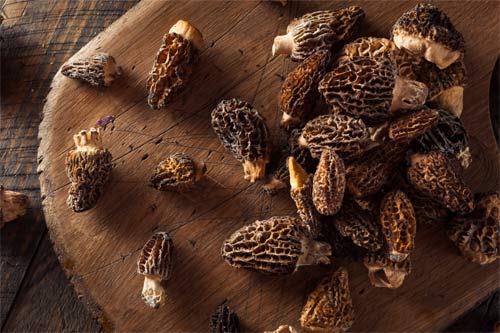
Morel mushrooms, the tops of which resemble small shower loofahs, are packed with immune-boosting, disease-preventing vitamin D. Their taste has been described as umami, or savory. Rarely cultivated, morel mushrooms are typically wild harvested and picking the mushrooms is a popular tradition for many.
That said, avoid picking mushrooms in the wild unless you are absolutely sure you know what you're picking. There are a number of toxic mushrooms, including a species called “false morels,” and it's easy to get them confused unless you have a lot of experience and know what to look for.
As noted in a 2017 study,5 “Morels have been in use in traditional medicine for centuries, due to their health-related benefits, and current research demonstrated their anti-oxidative and anti-inflammatory bioactivities, in addition to immunostimulatory and antitumor properties.”
Most of the health benefits have been attributed to polysaccharides, along with a number of phytochemicals, primarily phenolic compounds, tocopherols, ascorbic acid and vitamin D. Morel mushrooms are an excellent addition cooked with any side dish and go great with all kinds of meat and fish.
Many people enjoy eating them as a side dish on their own, gently sautéed for five to 10 minutes with a pat of butter. Never eat morel mushrooms raw, as they contain trace amounts of a toxin that make some people ill.
No. 2: Fiddlehead Ferns
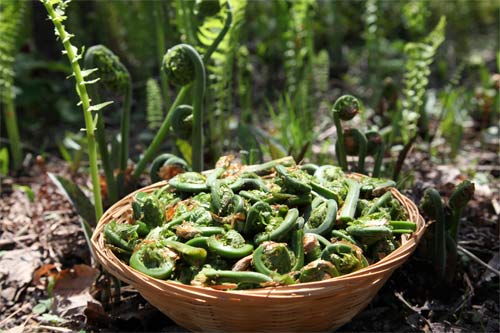
Chances are you’ve never heard of fiddlehead ferns6 unless you’re a frequent visitor of farmers markets and specialty health food stores. As the name implies, the small curly discs are picked from immature, uncoiled ostrich ferns. The taste has been likened to that of asparagus, but with bit more crunch and bitterness. Others say they taste like a mix of asparagus, spinach and broccoli all in one.
High in antioxidants (twice the amount of blueberries) and plant-based omega-3, fiddlehead ferns are a potent anti-inflammatory food.7 They also contain vitamins A and C, both of which are important for healthy vision and immune function. Iron and phosphorous aid red blood cell production and are important for healthy formation of cell membranes and bone, while potassium supports heart health and electrolyte and muscle functions.
Fiddleheads are commonly picked in Maine and Canada, but can often be found in health food stores. Their season is quite brief — two to three weeks at the most. To ensure quality, look for specimens that have tightly coiled heads with stems about 2 inches in length. If picking your own, make sure you know how to identify ostrich ferns, as they are commonly confused with bracken fern — a species known to cause cancer in lab animals.
Also, fiddleheads may cause gastrointestinal upset when consumed raw, so light cooking, just as you would asparagus, is recommended. They can also be pickled for longer shelf life. For instructions, see this spicy pickled fiddleheads recipe by The Spruce.8
The following video will help you properly identify edible fiddleheads from the ostrich fern. Consider adding them to dishes that normally call for asparagus. Many recipes suggest eating them steamed or boiled with hollandaise sauce, cooked then chilled and topped with plain mayo, or lightly sautéed and tossed with some butter, lemon, vinegar and Parmesan cheese.

Download this Article Before it Disappears
Download PDFNo. 3: Cherimoya
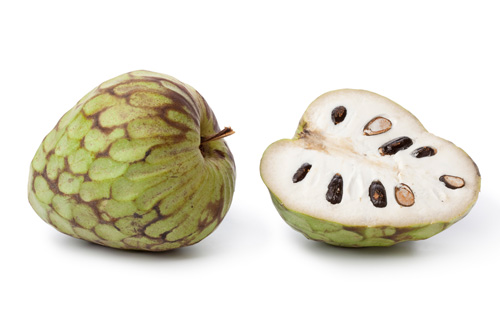
This heart-shaped “dragon-scaled” tropical fruit has a sweet, buttery inside. Select specimens that are hard and green. As avocados, cherimoyas ripen quickly on the counter. Once the skin turns a bronze color and feels soft to the touch, it’s ready to eat. Simply peel and slice. Their flavor has been likened to a combination of banana, papaya and pineapple. Pureed, they can also be added to smoothies.
A single fruit contains approximately 60% of the daily recommended dose of vitamin C and a third of your vitamin B6 needs. In Mexico, the fruit has traditionally been used to ease anxiety, thanks to the presence of GABA (gamma-aminobutyric acid), which has mild antidepressive effects.
It’s also high in fiber, iron and niacin, and contain powerful compounds shown to combat cancer, malaria and human parasites. Cherimoya provides high amounts of potassium that help control heart rate and blood pressure. Furthermore, it contains more minerals weight per weight than a lot of more common fruits, including apples.
No. 4: Sorrel
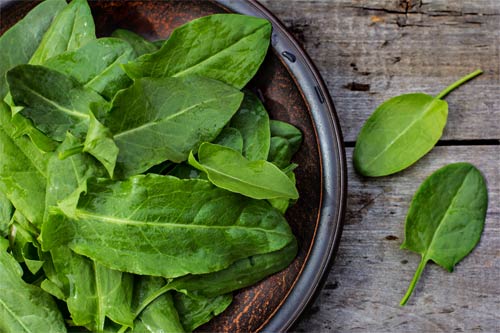
Sorrel, also known as spinach dock or narrow-leaved dock, is a perennial leafy herb cultivated around the world. Packed with health benefits and a tangy, lemony flavor, it adds a bit of zing to just about any salad or dish, including creamy soups.
One cup of sorrel provides more than your daily requirement of vitamins A and C, along with high amounts of potassium and iron. Keep in mind that sorrel contains oxalic acid, which is contraindicated for those struggling with or prone to oxalate kidney stones. For most people, small quantities are completely safe and provide valuable health benefits. According to Organic Facts:9
“The health benefits of sorrel include its ability to improve eyesight, slow the aging process, reduce skin infections, strengthen the immune system, and improve digestion. It also builds strong bones, increases circulation, increases energy levels, helps prevent cancer, lowers blood pressure, increases appetite, protects against diabetes, strengthens heart health and improves kidney health.”
No. 5: Stinging Nettles
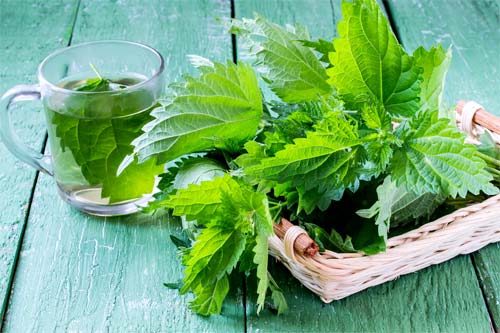
While typically considered a pesky and painful weed, stinging nettles10 have unique health benefits. (On a side note, should you have them growing in your yard, they’re actually a sign of rich, healthy soil.) Just make sure you use gloves during handling until they’ve been cooked, to avoid a painful rash.
Once blanched or sautéed, they can be safely consumed, providing healthy amounts of vitamin K and calcium. Traditionally, nettles have been valued for its blood purifying properties, and can also be made into tea, said to ease congestion and soothe allergies and asthma.
Nettle tea may also boost milk production if you’re nursing, and helps stimulate your digestive glands, including your intestines, liver, pancreas and gallbladder.
No. 6: Purslane
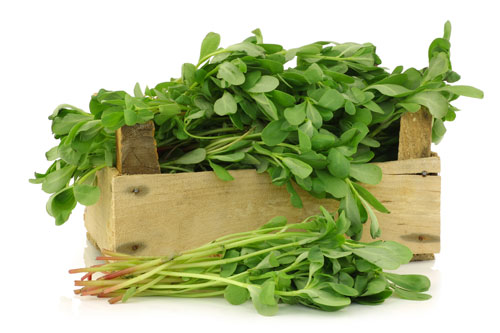
Purslane11 (also called duckweed, fatweed, pigweed, pusley, verdolaga, ma chi xian in Chinese, munyeroo or wild portulaca), is the omega-3 powerhouse of the vegetation kingdom, and there's a high probability it's growing in your yard right now. According to Mother Earth News, it's the most reported weed species in the world.12
Purslane looks very much like a miniature jade plant, with fleshy succulent leaves and reddish stems. The stems grow flat to the ground and radiate outward from a single taproot, sometimes forming large, flat circular mats up to 16 inches across. In about mid-July, it develops tiny yellow flowers about one-quarter inch in diameter.
Seeds of purslane are extremely tough, some remaining viable in the soil for 40 years, and it can grow in almost anything, from fertile garden loam to the most arid desert soil — even in your rock driveway. Just be very careful not to confuse purslane with spurge, because they can look similar, and spurge will make you sick. The following video shows how to tell them apart.
Purslane has a stellar omega-3 fatty acid profile, compared to other vegetables, containing anywhere from 300 to 400 milligrams (mg) of omega-3 per cup. It also contains six times more vitamin E than spinach, seven times more beta carotene than carrots, providing about 44% of your daily vitamin A needs per 100 grams,13 25 mg of vitamin C per cup, plus magnesium, calcium, iron, riboflavin, potassium, phosphorous and manganese.
Purslane can be eaten either raw or cooked. If you're planning on eating raw purslane, make sure no pesticides or herbicides have been used nearby. If you’ve been spraying Roundup in your yard, never eat weeds collected from the area. Also avoid them if your neighbor has used Roundup in their yard, as the chemicals can easily drift across property lines.
As a precaution, wash the leaves and stems thoroughly before consuming. Typically, people eat the young purslane leaves and stems to avoid the tougher parts of the plant. For cooked purslane, there are numerous ways to incorporate this herb in your favorite dishes. You can boil it in water for 10 minutes and drain, or simply add it to other recipes to give the dish an added crunch.
No. 7: Ramps
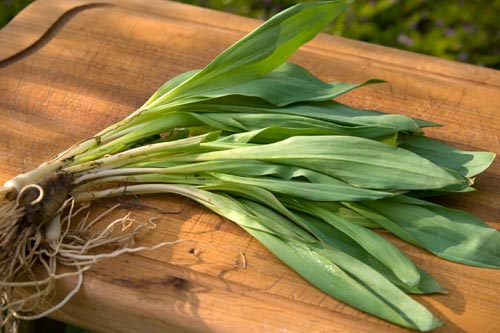
Ramps is a type of wild leek, featuring small white bulbs with hairy roots. While resembling green onions in appearance, their flavor is more akin to garlic. If you’re lucky enough to find them, be sure to get some. Ramps are exceedingly scarce as they’re a slow grower, and are only in season for a few weeks in spring.
Look for specimens that are firm, with bright green leaves. Don’t buy or use them if you notice brown spots or slimy areas. Unwashed and wrapped in a plastic bag, ramps can be refrigerated for up to a week. Ramps are a good source of vitamins A and C, selenium and chromium, the latter of which helps stabilize blood sugar. As for how to use them in your cooking, Organic Authority suggests:14
“[U]se ramps as you would scallions, green onions or leeks. Anything that would pair well with garlic or leeks will love the ramp. Slice them thinly and use sparingly, and also handle them gently, adding them at the end of the cooking process. Think simple to allow ramps to shine: Scrambled into eggs, garnished alongside seafood, mixed into big bowls of pasta, or oven roasted or grilled to perfection.”
How to Find Locally Grown Food That Is in Season
When you eat locally grown foods, the contents of your shopping bag inevitably change with each passing season. In other words, adjusting what you eat to what’s in season becomes an inescapable fact if you’re going to eat locally grown foods, and if you keep this in mind, it can become a pleasurable part of your culinary experimentation. Here are some tips for tracking down locally grown foods that are in season:
- If you’re lucky enough to have a local farmers market, that’s the way to go. For a listing of national farmers markets and local food directories, see the USDA’s website. Another great resource is www.localharvest.org.
- Another good route for finding local food is to subscribe to a community supported agriculture program (CSA). Some are seasonal while others offer year-round programs. Once you subscribe, many will drop affordable, high-quality locally grown produce right at your door step. For a comprehensive list of CSAs and a host of other sustainable agriculture programs, check out my Sustainable Agriculture page.
- Local farmers are perhaps your best source for seasonal produce. You can search for local farms on www.localharvest.org.
- Shop at your local natural food store or health co-op, as many of them get their produce from local farmers.
- If everything else fails, shop at your locally owned grocers rather than large chain supermarkets. Many small private grocers also supply produce from local sources.
Eight Signs of High-Quality Food
Last but not least, here are some general tips on what to look for when trying to determine the healthiest foods possible, no matter where you shop. You’ll want to look for foods that are:
- Grown without pesticides and chemical fertilizers (organic foods fit this description, but so do some nonorganic foods). If harvesting edible weeds or plants from your garden, make sure no pesticides or herbicides have been applied in the area
- Not genetically modified
- Contains no added growth hormones, antibiotics or other drugs
- Does not contain artificial anything, nor any preservatives
- Fresh (if you have to choose between wilted organic produce or fresh conventional produce, the latter may be the better option)
- Did not come from a factory farm
- Grown with the laws of nature in mind (meaning animals are fed their native diets, not a mix of grains and animal byproducts, and have free-range access to the outdoors)
- Grown in a sustainable way (using minimal amounts of water, protecting the soil from burnout and turning animal wastes into natural fertilizers instead of environmental pollutants)
- 1 Science Daily June 7, 2007
- 2, 3 ATTRA NCAT. Food Miles; Background and Marketing
- 4 Reader’s Digest, Spring Superfoods
- 5 Crit Rev Food Sci Nutr. 2017 Mar 28:1-14
- 6 The Spruce February 13, 2018
- 7 Healthy Focus, Fiddlehead Ferns
- 8 The Spruce, Spicy Pickled Fiddleheads
- 9 Organic Facts, Sorrel Benefits
- 10 Mother Earth News, Stinging Nettles
- 11 Wisconsin Horticulture. Common Purslane
- 12 Mother Earth News April/May 2005
- 13 Nutrition and You, Purslane
- 14 Organic Authority, Ramps

Commentaires
Enregistrer un commentaire